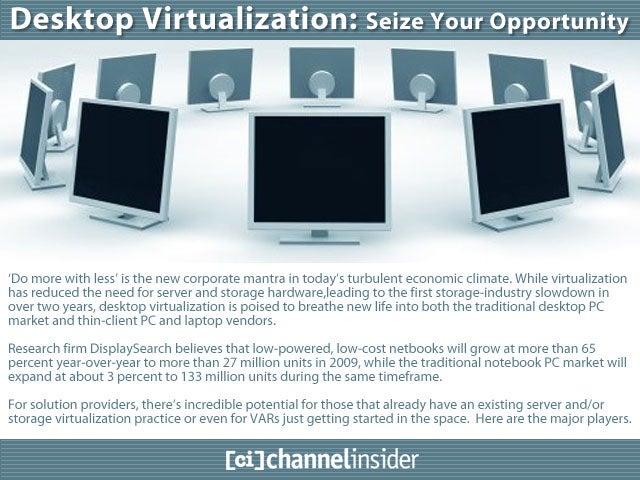 Desktop Virtualization Seize Your Opportunity
Desktop Virtualization Seize Your Opportunity
‘Do more with less’ is the new corporate mantra in today’s turbulent economic climate. While virtualization has reduced the need for server and storage hardware, leading to the first storage-industry slowdown in over two years, desktop virtualization is poised to breathe new life into both the traditional desktop PC market and thin-client PC and laptop vendors.Research firm DisplaySearch believes that low-powered, low-cost netbooks will grow at more than 65 percent year-over-year to more than 27 million units in 2009, while the traditional notebook PC market will expand at about 3 percent to 133 million units during the same timeframe.For solution providers, there’s incredible potential for those that already have an existing server and/or storage virtualization practice or even for VARs just getting started in the space. Here are the major players.
 No Title
No Title
VMware is the granddaddy of virtualization. The innovative software company, now partly owned by EMC and VMware, offers a number of options, including its View (formerly Virtual Desktop infrastructure), VMware ThinApp and VMware ACE software.The VMware View portfolio runs virtual desktop instances centrally from the datacenter and pushes them to any device. ThinApp is designed specifically to speed distributed application deployments over a virtualized desktop infrastructure, while ACE includes enhanced security features to simplify and secure management of virtual desktops in remote or branch locations.
 No Title
No Title
Citrix’s XenServer is the second-best known virtualization platform, and the company’s recent partnership with Microsoft – through which XenEnterprise can manage Windows Hyper-V hypervisor and XenDesktop can connect to virtual desktops hosted on Windows 2008-has helped elevate its profile and market reach significantly.XenDesktop uses a unique approach, allowing solution providers and administrators to use a single virtual desktop image to deliver personalized virtual desktops to both virtual and physical devices-in the datacenter or at the endpoint.
 No Title
No Title
Microsoft Hyper-V, codenamed Viridian, was formerly known as Windows Server Virtualization. Hyper-V is an x64 virtualization platform that offers a choice of two architectures, static or dynamic, depending on solution providers and customer needs.In static mode, each user is assigned their own virtual machine, all of which are stored on a centralized server. Desktop images can be pushed to either a PC or a thin-client. The dynamic architecture option creates only one master image. Users access applications on the virtual machine using Microsoft Application Virtualization, and all data is stored centrally on the server.
 No Title
No Title
NComputing’s proprietary desktop virtualization solution was developed in house, and unlike competitors, includes both software and associated hardware appliances on which the platform runs. Costs per-seat for better-known desktop virtualization solutions can run about $1,000 per user, whereas with the NComputing solution range from $70 to $200 per seat.Because the entire solution is manufactured in-house, Ncomputing solutions offer a drastically lower price, and Ncomputing targets cash-conscious markets like education, healthcare and manufacturing as well as enterprise customers with multiple branch offices.Ncomputing takes advantage of individual PCs’ excess capacity via an agent installed on a host machine that can connect to as many as 30 additional PCs that then function like sessions.
 No Title
No Title
Originally developed by German software firm Innotek, VirtualBox is now being developed by Sun Microsystems … soon to be part of Oracle Corporation.VirtualBox is a free, open-source virtualization package that supports desktops based on a broad range of guest operating systems, including Fedora, Mandriva, Red Hat, NetWare and Windows-from 3.1 to Vista and including Windows Server 2003 and Windows Server 2008. VirtualBox, however, doesn’t support Apple’s OS X, as Apple doesn’t allow its OSes to run on non-Mac hardware.

